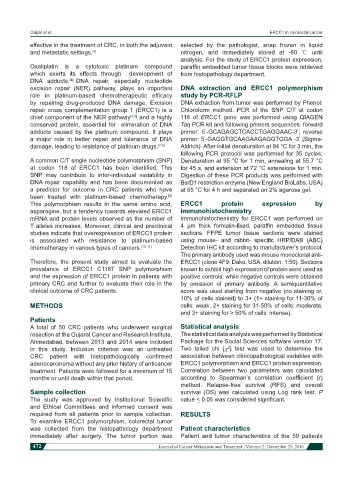Page 482 - Read Online
P. 482
Gajjar et al. ERCC1 in colorectal cancer
effective in the treatment of CRC, in both the adjuvant selected by the pathologist, snap frozen in liquid
and metastatic settings. [3] nitrogen, and immediately stored at -80 ℃ until
analysis. For the study of ERCC1 protein expression,
Oxaliplatin is a cytotoxic platinum compound paraffin embedded tumor tissue blocks were retrieved
which exerts its effects through development of from histopathology department.
DNA adducts. [4] DNA repair, especially nucleotide
excision repair (NER) pathway, plays an important DNA extraction and ERCC1 polymorphism
role in platinum-based chemotherapeutic efficacy study by PCR-RFLP
by repairing drug-produced DNA damage. Excision DNA extraction from tumor was performed by Phenol:
repair cross complementation group 1 (ERCC1) is a Chloroform method. PCR of the SNP C/T at codon
chief component of the NER pathway [5,6] and a highly 118 of ERCC1 gene was performed using QIAGEN
conserved protein, essential for elimination of DNA Taq PCR kit and following primers sequences: forward
adducts caused by the platinum compound. It plays primer: 5’-GCAGAGCTCACCTGAGGAAC-3’; reverse
a major role in better repair and tolerance of DNA primer: 5’-GAGGTGCAAGAAGAGGTGGA -3’ (Sigma-
damage, leading to resistance of platinum drugs. [7,8] Aldrich). After initial denaturation at 94 °C for 3 min, the
following PCR protocol was performed for 35 cycles:
A common C/T single nucleotide polymorphism (SNP) Denaturation at 95 °C for 1 min, annealing at 55.7 °C
at codon 118 of ERCC1 has been identified. This for 45 s, and extension at 72 °C extensions for 1 min.
SNP may contribute to inter-individual variability in Digestion of these PCR products was performed with
DNA repair capability and has been documented as BsrD1 restriction enzyme (New England BioLabs, USA)
a predictor for outcome in CRC patients who have at 65 °C for 4 h and separated on 2% agarose gel.
been treated with platinum-based chemotherapy. [9]
This polymorphism results in the same amino acid, ERCC1 protein expression by
asparagine, but a tendency towards elevated ERCC1 immunohistochemistry
mRNA and protein levels observed as the number of Immunohistochemistry for ERCC1 was performed on
T alleles increases. Moreover, clinical and preclinical 4 μm thick formalin-fixed, paraffin embedded tissue
studies indicate that overexpression of ERCC1 protein sections. FFPE tumor tissue sections were stained
is associated with resistance to platinum-based using mouse- and rabbit- specific HRP/DAB (ABC)
chemotherapy in various types of cancers. [10,11] Detection IHC kit according to manufacturer’s protocol.
The primary antibody used was mouse monoclonal anti-
Therefore, the present study aimed to evaluate the ERCC1 (clone 4F9: Dako, USA, dilution: 1:50). Sections
prevalance of ERCC1 C118T SNP polymorphism known to exhibit high expression of protein were used as
and the expression of ERCC1 protein in patients with positive controls, while negative controls were obtained
primary CRC and further to evaluate their role in the by omission of primary antibody. A semiquantitative
clinical outcome of CRC patients. score was used starting from negative (no staining or,
10% of cells stained) to 3+ (1+ staining for 11-30% of
METHODS cells: weak, 2+ staining for 31-50% of cells: moderate,
and 3+ staining for > 50% of cells: intense).
Patients
A total of 50 CRC patients who underwent surgical Statistical analysis
resection at the Gujarat Cancer and Research Institute, The statistical data analysis was performed by Statistical
Ahmedabad, between 2013 and 2014 were included Package for the Social Sciences software version 17.
2
in this study. Inclusion criterion was an untreated Two tailed chi (χ ) test was used to determine the
CRC patient with histopathologically confirmed association between clinicopathological variables with
adenocarcinoma without any prior history of anticancer ERCC1 polymorphism and ERCC1 protein expression.
treatment. Patients were followed for a minimum of 15 Correlation between two parameters was calculated
months or until death within that period. according to Spearman’s correlation coefficient (r)
method. Relapse-free survival (RFS) and overall
Sample collection survival (OS) was calculated using Log rank test. P
The study was approved by Institutional Scientific value < 0.05 was considered significant.
and Ethical Committees and informed consent was
required from all patients prior to sample collection. RESULTS
To examine ERCC1 polymorphism, colorectal tumor
was collected from the histopathology department Patient characteristics
immediately after surgery. The tumor portion was Patient and tumor characteristics of the 50 patients
472 Journal of Cancer Metastasis and Treatment ¦ Volume 2 ¦ December 29, 2016

